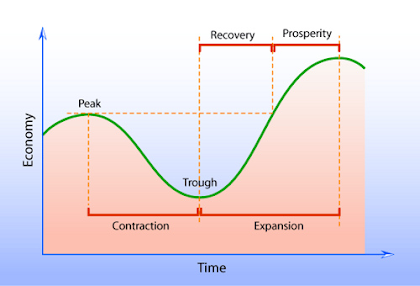What is Trade Cycle? Meaning Definition Features and Types
 What is Trade Cycle? Meaning
What is Trade Cycle? Meaning
The alternating periods of expansion and contraction in the economic activity has been called business cycles or trade cycles.
Image Credits © Havayolu101.
The period of high income, high output and high employment is called as the Period of Expansion, Upswing or Prosperity.
The period of low income, low output and low employment is called as the Period of Contraction, Recession, Downswing or Depression.
 Definition of Trade Cycle
Definition of Trade Cycle
According to Keynes,
"A trade cycle is composed of periods of Good Trade, characterized by rising prices and low unemployment percentages, shifting with periods of bad trade characterized by falling prices and high unemployment percentages."
 Features of Trade Cycle
Features of Trade Cycle
The characteristics or features of trade cycle are :-
- Movement in Economic Activity : A trade cycle is a wave-like movement in economic activity showing an upward trend and a downward trend in the economy.
- Periodical : Trade cycles occur periodically but they do not show the same regularity.
- Different Phases : Trade cycles have different phases such as Prosperity, Recession, Depression and Recovery.
- Different Types : There are minor and major trade cycles. Minor trade cycles operate for 3-4 years, while major trade cycles operate for 4-8 years or more. Though trade cycles differ in timing, they have a common pattern of sequential phases.
- Duration : The duration of trade cycles may vary from a minimum of 2 years to a maximum of 12 years.
- Dynamic : Business cycles cause changes in all sectors of the economy. Fluctuations occur not only in production and income but also in other variables like employment, investment, consumption, rate of interest, price level, etc.
- Phases are Cumulative : Expansion and contraction in a trade cycle are cumulative, in effect, i.e. increasing or decreasing progressively.
- Uncertainty to businessmen : There is uncertainty in the economy, especially for the businessmen as profits fluctuate more than any other type of income.
- International Nature : Trade Cycles are international in character. For e.g. Great Depression of 1930s.
 Types of Trade Cycle
Types of Trade Cycle
Dynamic forces operating in a capitalist economy create various kinds of economic fluctuations. These fluctuations can be classified as follows :-
- Short-Time Cycle : This trade cycle occur for a short period of time. It is also known as minor cycles. It lasts for about 3-4 years.
- Secular Trends : This trade cycle occurs for a long period of time and is known as Long term cycle. It lasts for about 4-8 years or more. It is also known as major cycle.
- Seasonal Fluctuations : This refers to trade cycles, which take place due to seasonal changes in the economy. For e.g. failure of monsoon can cause a downtrend in the economy which may be followed by a good monsoon and up to trend.
- Irregular or Random Fluctuations : These trade cycles are unpredictable and occur during a period of strikes, war, etc., causing a shock to the economic system.
- Cyclic Fluctuation : These fluctuations are wave-like changes in economic activity caused by recurring phases of expansion and contraction. There is an upswing from a trough (low point) to peak and downswing from the peak to trough caused due to economic changes in demand, or supply or various other factors.

No Comment Yet
Please Comment